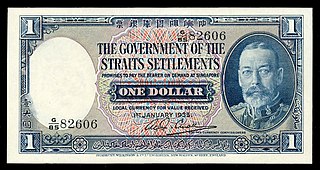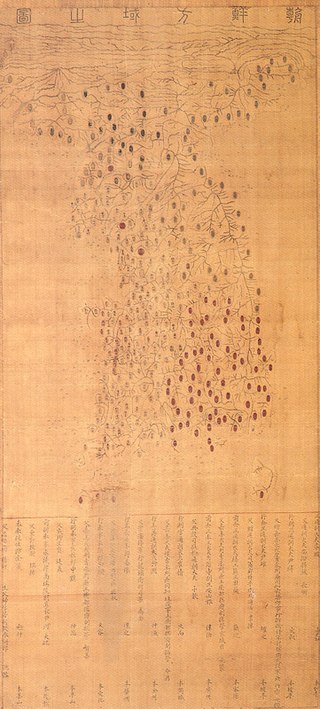The pitis was a currency of Brunei last issued in 1868 which circulated into the 20th century. It is also referred to as the picil by Antonio Pigafetta [1] and some variants of it were referred to as the kue and the paku (English: piece). It was later replaced by the Straits dollar in Brunei, which is valued at 4,000 pitis [2] or 800 paku [3] and at par with the Spanish dollar.
Before the introduction of coins to Brunei, Cowrie shells were used as bartering currency in purchasing small items. [4] Brunei is also famous for its bronze teapots, which were used as currency in barter trade along the coast of North Borneo.
The first coinage used in Brunei were Chinese coins [5] which were first type of coins to be referred to as the pitis in Brunei. [3] Its use probably started with the Chinese contact with Brunei between the 9th and 12th century. [1]
When Antonio Pigafetta who was Ferdinand Magellan's chronicler visited Brunei in 1521, he wrote "The money is made out of bronze pierced in the middle in order that it may be strung. On each side of it are four Chinese characters, which are letters of the Great King of China. We call the money picils." Picils is a reference to the pitis. [1]
In the 16th century, Brunei started issuing its own currency. These coins were known as pitis, with the Chinese "pitis" being referred to as kue to differentiate them from the Bruneian coins. Chinese coins continued to circulate in Brunei until around the second half of the 19th century. [1]
In addition to pitis and kue, silver Spanish dollars circulated with an exchange rate of 4,000 pitis = 1 dollar. [2] Iron ingots were also used as money, with 100 flat, inch square pieces worth 1 dollar. [1] Miniature cannons between 6 inches (150 mm) to a foot long were also used as currency. [4]
In 1906, Sultan Hashim agreed to have a British Resident in Brunei. He also acquiesced that the Straits dollar, used by the British in the Straits Settlement (Malaya), Singapore, North Borneo (Sabah) and Sarawak, should be used in Brunei. [6] Despite the introduction of the Straits dollar, the previous local monies were still used with peculiar exchange rates in the earlier days. All the previous pitis coins were called paku (English: piece) where 8 paku were equal to 1 cent or kayu (sakayu). [3] However, officially, 4,000 pitis equaled one dollar. [2]
Brunei's first coins were struck in a tin-lead alloy. These are further subdivided into about three sets. The earliest types bore an anonymous, flowery design. These were followed by issues of unnamed sultans. Finally, coins bearing the names of known Sultans were issued. These coins were struck from about the 16th century to about the 19th century. [1]
Coins of the unnamed Sultans have the honorific title of the Sultan minted on the coins. Some of the titles includes Malikul-Adil [7] (The Just Sultan) [4] and Malikul-Thahir (The Victorious Sultan). The title is generic though it has been speculated that the coins belonged to that of Sultan Hassan who ruled between 1605 and 1620. [1]
The first pitis [8] issued in Brunei with a definite date was that issued by Sultan Abdul Momin, who ruled from 1853 to 1885. The principal metal of this coin is lead with some tin content. On the front, the coin shows the Royal umbrellas and other Brunei state insignia. The coin also has an inscription translated as "By order of the State Financial Administration of Brunei, in the year of the Prophet 1285". [1] The year of the Prophet 1285, or 1285 Hijrah (AH 1285), is the date according to the Islamic calendar and it corresponds to AD 1868. The coins were of two denominations - 1⁄2 and 1 pitis. [2]
The last Sultan to issue his own coin was Sultan Hashim who issued the "star coin" [9] in 1886 (printed as AH 1304 on the coin) which was minted in Birmingham, England. [6] These coins were bronze and have on the obverse a star inside a circle with an Arabic inscription outside. The reverse has a "1" inside a circle with "SULTANATE OF BRUNEI 1304".

Dollar is the name of more than 20 currencies. The United States dollar, named after the international currency known as the Spanish dollar, was established in 1792 and is the first so named that still survives. Others include the Australian dollar, Brunei dollar, Canadian dollar, Eastern Caribbean dollar, Hong Kong dollar, Jamaican dollar, Liberian dollar, Namibian dollar, New Taiwan dollar, New Zealand dollar, Singapore dollar, Trinidad and Tobago Dollar and several others. The symbol for most of those currencies is the dollar sign $ in the same way as many countries using peso currencies. The name "dollar" originates from Bohemia and a 29 g silver-coin called the Joachimsthaler.

The Malaysian ringgit is the currency of Malaysia. It is divided into 100 sen. The ringgit is issued by the Central Bank of Malaysia.

The Brunei dollar, has been the currency of the Sultanate of Brunei since 1967. It is normally abbreviated with the dollar sign $, or alternatively B$ to distinguish it from other dollar-denominated currencies. It is divided into 100 sen (Malay) or cents (English). The Brunei dollar is issued by the Autoriti Monetari Brunei Darussalam.
The Singapore dollar is the official currency of the Republic of Singapore. It is divided into 100 cents. It is normally abbreviated with the dollar sign $, or S$ to distinguish it from other dollar-denominated currencies. The Monetary Authority of Singapore (MAS) issues the banknotes and coins of the Singapore dollar.

The Macanese pataca or Macau pataca is the currency of the Macau Special Administrative Region of the People's Republic of China. It is subdivided into 100 avos, with 10 avos called ho (毫) in Cantonese.

The history of Chinese currency spans more than 3000 years. Currency of some type has been used in China since the Neolithic age which can be traced back to between 3000 and 4500 years ago. Cowry shells are believed to have been the earliest form of currency used in Central China, and were used during the Neolithic period.
The pataca was a monetary unit of account used in Portuguese Timor between 1894 and 1958, except for the period 1942–1945, when the occupying Japanese forces introduced the Netherlands Indies gulden and the roepiah. As in the case of the Macanese pataca which is still in use today, the East Timor unit was based on the silver Mexican dollar coins which were prolific in the wider region in the 19th century. These Mexican dollar coins were in turn the lineal descendants of the Spanish pieces of eight which had been introduced to the region by the Portuguese through Portuguese Malacca, and by the Spanish through the Manila Galleon trade.
The Malayan dollar was the currency of the British colonies and protectorates in Malaya and Brunei until 1953. It was introduced in 1939, replacing the Straits dollar at par, with 1 dollar = two shillings four pence sterling.

The Straits dollar was the currency of the Straits Settlements from 1898 until 1939. At the same time, it was also used in the Federated Malay States, the Unfederated Malay States, Kingdom of Sarawak, Brunei, and British North Borneo.

The Malaya and British Borneo dollar was the currency of Malaya, Singapore, Sarawak, North Borneo, Brunei and the Riau archipelago from 1953 to 1967 and was the successor of the Malayan dollar and Sarawak dollar, replacing them at par. The currency was issued by the Board of Commissioners of Currency, Malaya and British Borneo. Prior to 1952, the board was known as the Board of Commissioners of Currency, Malaya.

The Japanese government-issued dollar was a form of currency issued for use within the Imperial Japan-occupied territories of Singapore, Malaya, North Borneo, Sarawak and Brunei between 1942 and 1945. The currency was also referred to informally as banana money, named as such because of the motifs of banana trees on 10 dollar banknotes. The Japanese dollar was in widespread use within the occupied territories where the previous currency became scarce. The currency were referred to as "dollars" and "cents" like its predecessors, the Straits dollar, Malayan dollar, Sarawak dollar and British North Borneo dollar.

Money is any item or verifiable record that is generally accepted as payment for goods and services and repayment of debts, such as taxes, in a particular country or socio-economic context. The primary functions which distinguish money are as a medium of exchange, a unit of account, a store of value and sometimes, a standard of deferred payment.

Korean currency dates back as far as the Goryeo dynasty (918–1392) when the first coins were minted. The coins, cast in both bronze and iron, were called tongbo and jungbo. Additionally, silver vases called ŭnbyŏng were widely used and circulated as a currency among the aristocracy of Goryeo.
The keping was the currency of Kelantan until 1909 when it was replaced by the Straits dollar. It was subdivided into 10 pitis. Coins were struck in tin in denominations of 1 pitis (holed), 1 and 10 keping.
The keping was the currency of Trengganu until 1909 when it was replaced by the Straits dollar. It was subdivided into 10 pitis. Coins were issued in denominations of 1 pitis (tin), 1 keping (copper) and 10 keping (tin).
The banknotes of the Sungei Buloh Settlement were issued as leprosy colony money in 1935 and 1936, at Sungai Buloh, Selangor, British Malaya when it was a leper colony. The currency was pegged to the Straits Settlements dollar. These notes are extremely scarce. They were all printed by the Survey Department, Federated Malay States. They have never been listed in the Standard Catalog of World Paper Money.

Silver Dragon coins, also sometimes known as Dragon dollars, are silver coins issued by China, Japan and later Korea for general circulation in their own countries. Featuring a dragon on the obverse of Japanese and Korean issues and on the reverse of Chinese issues, all were inspired by the silver Spanish dollar which following its introduction into the region in the 16th Century had set the standard for a de facto common currency for trade in the Far East, this specification being a weight of 27.22 grams and a fineness of .900; the coin thus contained 24.5 g of silver.
The history of Philippine money covers currency in use before the Hispanic era with gold Piloncitos and other commodities in circulation, as well as the adoption of the peso during the Hispanic era and afterwards.

The Palembang pitis was a currency issued by the Palembang Sultanate from the 1600s until 1825 when the sultanate was dissolved and its territory taken over by the colonial government of the Dutch East Indies. The currency consisted of low denomination tin alloy coins which were mostly traded in bulk. Due to the lack of a centralized mint, the pitis often had inconsistent manufacture and were frequently counterfeited.
| Preceded by: cowrie shells | Currency of Brunei 9th to 12th Century – 1906 | Succeeded by: Straits dollar Ratio: Officially 4,000 pitis = 1 Straits dollar Unofficially 800 paku = 1 Straits dollar |